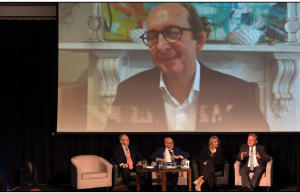“Are you ready to rumble” in the insolvency jungle was the opening question at the Association of Independent Insolvency Practitioners conference at the Hyatt Hotel in Canberra on 23-24 June 2022 and those two days were indeed a ringside rumble with 150 participants taken through many contentious issues in current insolvency practice.
Opening on Thursday 23rd with cannon blasts and all the activity of a boxing ring, it was an opportunity for members of the AIIP – registered company liquidators and bankruptcy trustees – to get together and discuss and try to resolve many current issues. These discussions proceeded through the formal presentations of expert speakers – with generous time allowed for ringside questions; and through outside discussions, during the breaks over coffee and meals, and walks in the cold Canberra air, or the many warm spaces within the Hyatt.
That ringside rumble well described the opening and early [8.30am, full-house] session with Henry Carr and Janine Cole of FEG, with close examination of a number of difficult scenarios involving the complexity concerning competing claims over circulating assets –as to the allocation of practitioners’ trading losses and general costs, the spending of circulating funds to chase free assets, and the voluntary administrator’s lien and a failed trade-on. A potential test case was mentioned. Other issues included FEG’s right to demand documents without the constraints of reasonableness, although with assurance that the model litigant overlay on FEG would be respected; and the constraints of retaining employees in a trade on in light of laws limiting redundancy rights for employers of less than 15 in number.
Following the formal opening of the conference by AIIP President Stephen Hathway, Ben Forrester of Macquarie Bank gave a very useful economic update, followed by Patrick Coghlan of CreditorWatch, each trying to discern some market trends in a volatile economic and international environment, in order to assist in anticipating insolvency numbers, and industries.
Blake O’Neill of ERA Legal chaired a ‘rumble with the regulators’ panel – Paul Shaw of AFSA (online), Thea Eszenyi of ASIC, and Henry Carr. Discussions included the state of the market, expectations of the regulators, and pre-insolvency advisers.
A series of TED talks followed. Whether small business restructurings under Part 5.3B are a “joke or the real deal” was answered by Ginette Muller of GM Advisory as being a bit of both, but with the message that the director’s overall financial position should receive attention, before and after the restructuring. Richard Morrow of JR Morrow P L promised practitioners a “good night’s sleep” through having regular practice reviews conducted, as might Emily Shoemark of Succession Plus in her TED talk advice on “succession planning – what do I have to offer and who will take it over”? and the need for engaging with employees and planning ahead. While Oliver Rainbow of PRISM Executive Recruitment referred to the “”Headache + Headache = Staffing”, in the current high employment environment, real consideration needs to be given to attracting and retaining staff and hence to “working from home? office? or both.”
Shabnam Amirbeaggi of Crouch Amirbeaggi then moderated a “tag team” from the professional accounting bodies, “industry bodies” under the law – IPA’s Vicki Stylianou, Jill Lawrence of CAANZ and CPA’s Kristen Beadle. Each spoke much of their advocacy and representation skills but collectively may have battled to fully satisfy a question from the audience – “what have you ever done for us?” – even as to how they monitor and oversight their IPs members under the insolvency laws.
The conference dinner was held at the spectacular National Gallery of Australia on the Thursday evening, with an intriguing dinner talk from the Chief Operating Officer of the National Portrait Gallery, Trent Birkett, who offered guidance on how one might get one’s own portrait hung – fame being a threshold. A good night was had by all.
On Friday day 2, Peter Switzer opened the session with an expansive keynote analysis of the economy and the state of the country and its apparent direction and dangers ahead. This was not at all diminished by the fact that, as one of the several Covid sufferers, Peter appeared on-line, looming large on the screen over the audience.

Peter Switzer, Mark Adams, David Levi, Ana Marinkovic and Bruce Billson
Peter continued with his chairing of “the great reset – who will come out of the ashes?” – a panel discussion around the challenges and changes for SME’s following the last 2 years under COVID-19 – involving the law, access to finance, and cultural and other changes needed for survival. The panel comprised NAB’s Ana Marinkovic, Mark Adams of ASIC and Bruce Billson of the ASBFEO, with a delayed entry by Vivek Chaudhary of the ATO, ably held together by David Levi of Levi Consulting. The program asked the audience to “be prepared to participate in an active debate of the issues” and that was well fulfilled.
After explaining “how good is Queensland?” and its many attributes, the TED talk of Assistant Professor Ian Stevens of Bond University explained the success of the AIIP introductory insolvency course, comprising 10 self-paced modules on particular issues in insolvency. The course is well focused on new entrants into insolvency.
The title of the TED talk by Michael Jones of Jones Partners “DIRRI What the ****?” Different firms, different standards”, and suggesting that size does matter when disclosing conflicts, indicated a certain dissatisfaction with the different treatment of big and small firms in relation to DIRRIs and independence when disclosing conflicts. In particular in relation to SMEs, Michael said that insolvency practitioners registered as liquidators and trustees should be able to treat their insolvency from a holistic perspective, as having blended corporate and personal debt, and assets, a feature of SMEs earlier raised by the Ombudsman, Bruce Billson.
The Friday afternoon session contained some heavy topics. Thomas Russell of Piper Alderman gave us a guided tour of the law of trusts, “Hello! Have we got a way forward yet?”, taking us through the last ten years of uncertainties to some claimed settled position from the High Court. Law reform is pending, if the government acts on the recent Treasury inquiry, one option being to limit the tax breaks that make trading trusts so “popular”. Thomas’ helpful tip in relation to small value assets held on trust – to sell them, regardless – generated some legal concern, but it made sense, on a risk management basis.
And a safe harbour panel – “Where has it been, where is it heading” – of Shane Deane of Dye & Co and Ginette Muller, moderated by Warren Jiear of HWL Ebsworth, examined the use of the safe harbour protection in assisting in on-going restructuring advice for larger SMEs, with discussion including the example of a business that nevertheless ended in liquidation.
Rounding off the afternoon, and the conference, and to a healthy audience in numbers, was a trio from Korda Mentha, on “Crypto Currency”, with two crypto experts – Tim Myers and Luke Bradley – and Paul Hewson as the practitioner providing practical comments.
Cannon blasts of confetti appropriately marked the end of the conference.
Such was the packed program, impacted here and there by Covid and air travel delays, AFSA’s “bankruptcy update” session could unfortunately not be held. Instead, it will form an AIIP lunchtime discussion session in the near future.
Sponsors
The conference was well supported by its many sponsors, with their representatives taking part as speakers or attendees throughout. The major conference sponsors were Macquarie Bank and Xcllusive Business Sales, with session sponsors being Grays, Hymans, PRM, Slattery, Piper Alderman, CreditorWatch, Bond University, Willis Towers Watson (WTW) and ERA Legal. The AIIP was also pleased to have many government representatives attending or speaking – from the Ombudsman’s office, FEG, AFSA and ASIC, and from the ATO.
Thanks
This conference came after a long Covid induced break after the successful 2019 conference in Canberra. This one was as successful if not better. Three qualities of AIIP conferences, among many, ensured that success – the quality and expertise of the speakers, the focus on registered liquidator and trustee AIIP members as attendees, and the collegiate and open nature of the discussions.
The AIIP acknowledges the considerable efforts that went in to organising the conference through a committee comprising John Morgan, Stephen Hathway, Shabnam Amirbeaggi, David Levi, and Ginette Muller.
This review
I attended the conference at the kind invitation of the AIIP. I cannot do justice to any of the high-quality sessions described but I hope this review stands as some record of what in my view was a very good insolvency conference.
Michael Murray
30 June 2022
A PDF of this review is at this link: AIIP conference 2022 – summary – M Murray.docx.1.docx.2.2



